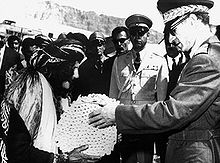Referendum in Iran in 1963
The 1963 referendum in Iran was a referendum on the White Revolution of Iran . Shah Mohammad Reza Pahlavi had his 6-point program confirmed by a referendum on January 26, 1963. The big landowners and clerics, above all Ruhollah Khomeini , were against a referendum and called for a boycott.
Result and consequences
| be right | % | |
|---|---|---|
| Yes | 5,589,711 | 99.93 |
| No | 4.115 | 0.07 |
| total | 5,593,826 | 100% |
With the approval of the Iranians for the planned reform projects, the following reforms could be implemented:
- Abolition of the feudal system and distribution of arable land from large landowners to farmers
- Nationalization of all forests and pastures
- Privatization of state industrial companies to finance the compensation payments to the large landowners
- Profit sharing for workers and employees of companies
- General active and passive voting rights for women
- Combating illiteracy by building an auxiliary teacher corps
After the referendum, Ruhollah Khomeini opposed the reforms and attacked the Shah personally on June 3, 1963. Khomeini's call against the reforms sparked riots in Iran in June 1963 and its arrest.
See also
Individual evidence
- ↑ For Khomeini, a referendum was the prelude to destroying religion. 16 years later, when it came to power, he also used a referendum. → See: Constitutional referendum in Iran in March 1979
- ↑ Information from the Ministry of the Interior. See also: Hung-Chao Tai: Land Reform and Politics. A comparative analysis. University of California Press, Berkeley CA et al. a. 1974, ISBN 0-520-02337-4 , p. 330.
- ↑ According to estimates, Iran had a population of 23.8 million at the time, 16 million over the age of 16, half of whom were women who were not eligible to vote. 271,179 women - after a call - also voted; Their votes were counted, but not added to the result.
- ↑ Gholam Reza Afkhami: The Life and Times of the Shah. University of California Press, Berkeley CA et al. a. 2009, ISBN 978-0-520-25328-5 , p. 231.



